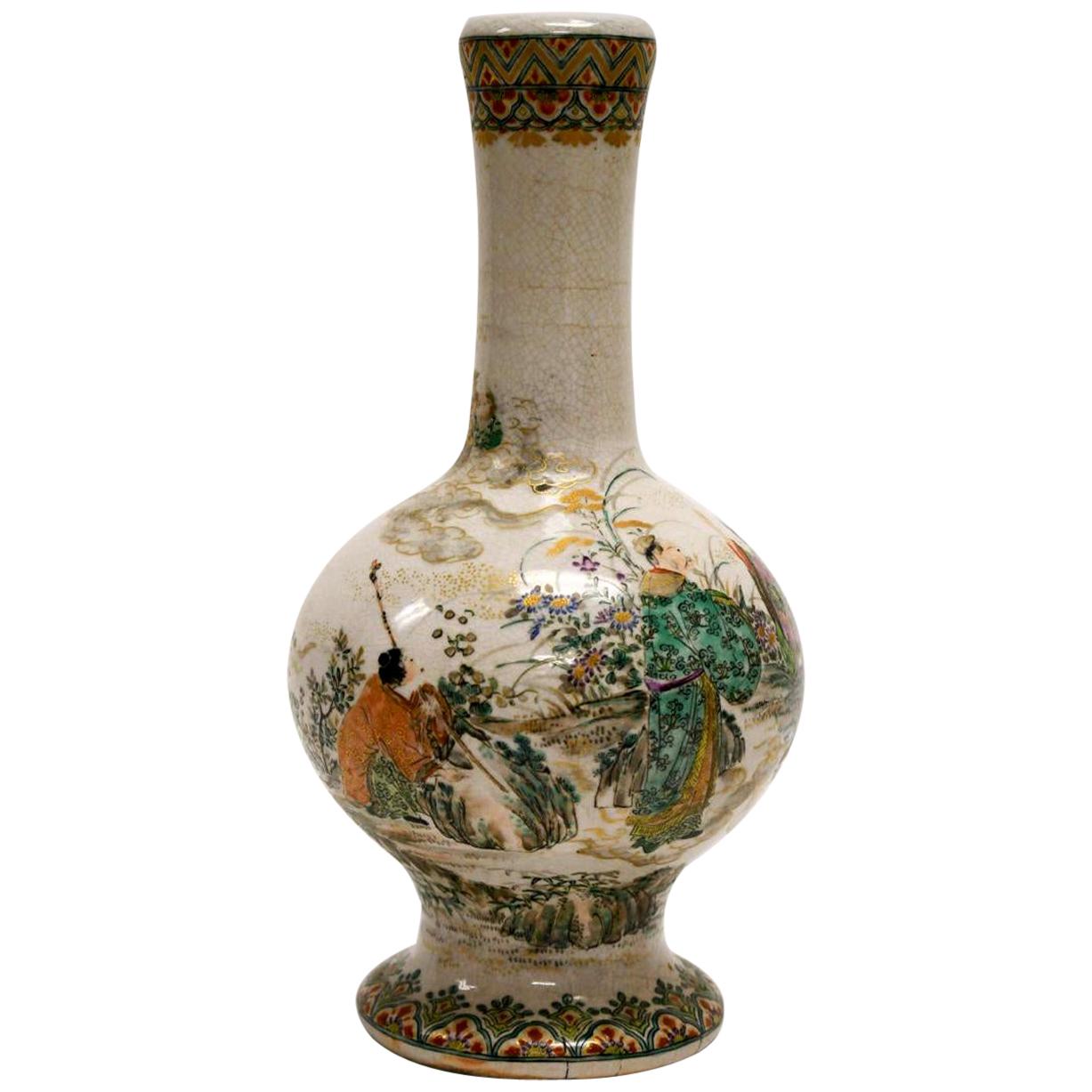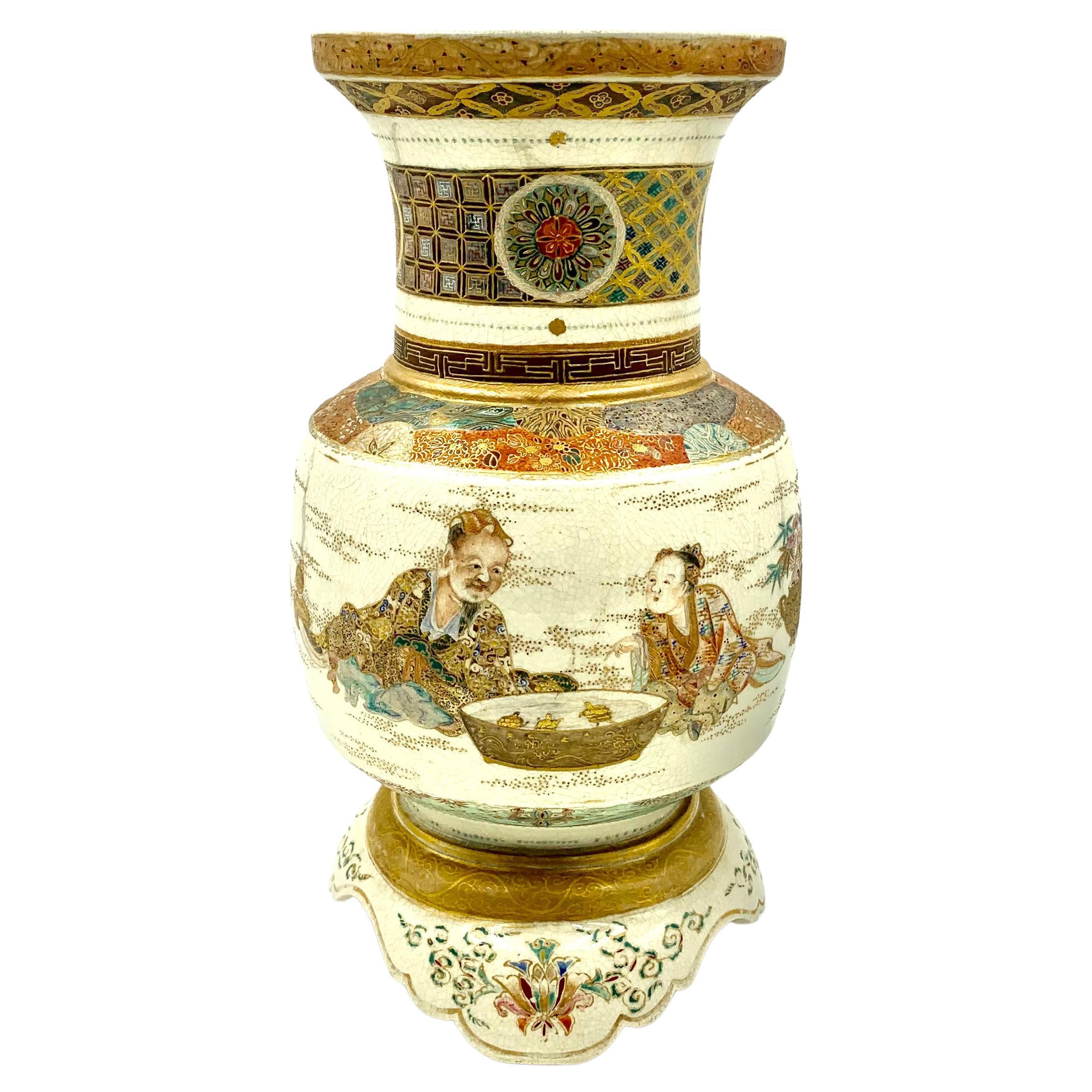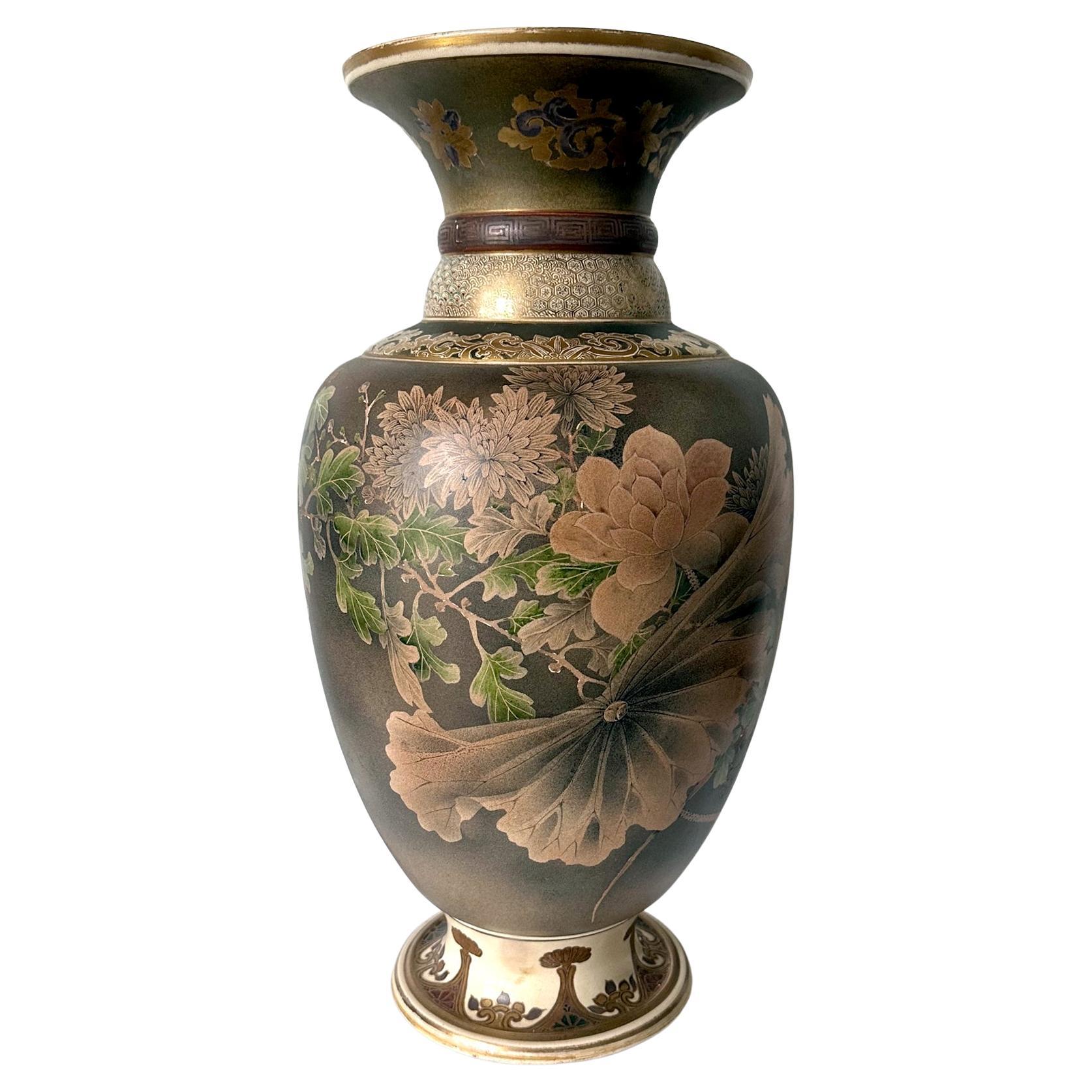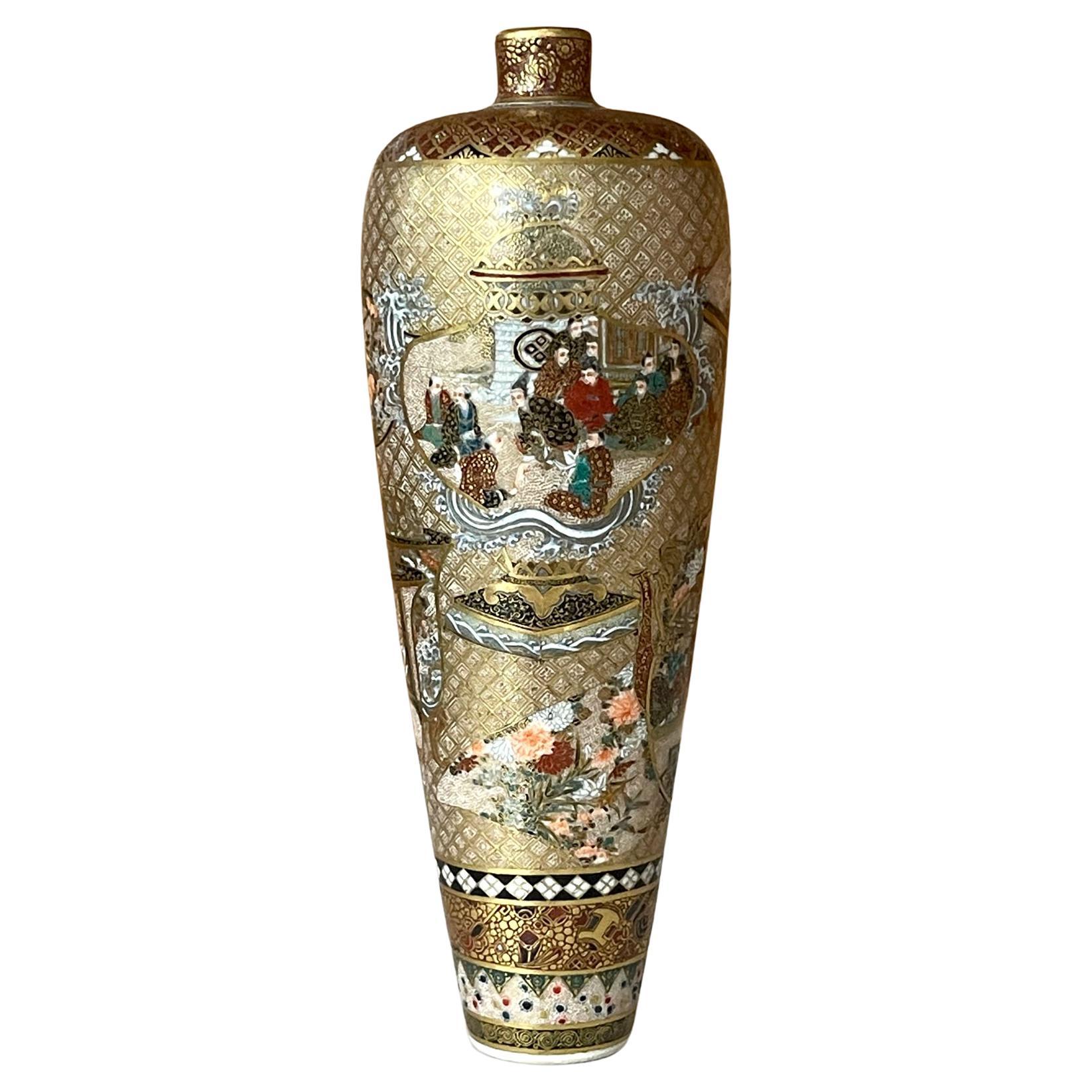Items Similar to Japanese Satsuma Vase with Figures
Want more images or videos?
Request additional images or videos from the seller
1 of 21
Japanese Satsuma Vase with Figures
About the Item
A mid-20th century Japanese Satsuma vase with figures.
Satsuma ware is a style of Japanese earthenware originally from the Satsuma region of what is today southern Kyushu. There are two distinct categories of this ware: The original plain dark clay early Satsuma made from circa 1600 and the elaborately decorated ivory-bodied pieces, which began to be produced in the 19th century as export products. By adapting their gilded polychromatic enamel overglaze designs to appeal to the tastes of western consumers, latter made Satsuma ware became one of the most recognized and profitable export products of the Meiji period (1868 - 1912)
- Dimensions:Height: 18.51 in (47 cm)Width: 8.27 in (21 cm)Depth: 7.09 in (18 cm)
- Style:Japonisme (In the Style Of)
- Materials and Techniques:
- Place of Origin:
- Period:
- Date of Manufacture:1950-1960
- Condition:Wear consistent with age and use.
- Seller Location:Antwerp, BE
- Reference Number:1stDibs: LU950412921101
About the Seller
4.9
Vetted Seller
These experienced sellers undergo a comprehensive evaluation by our team of in-house experts.
Established in 1988
1stDibs seller since 2012
973 sales on 1stDibs
Typical response time: <1 hour
- ShippingRetrieving quote...Ships From: Antwerp, Belgium
- Return PolicyA return for this item may be initiated within 3 days of delivery.
More From This SellerView All
- One of Two Chinese Porcelain Glazed Figural Ginger Jars with Lids, 19th CenturyLocated in Antwerp, BETwo Chinese blue and white porcelain glazed decorative figural and floral ginger jars with the original removable lids, 19th century. Measure: Diameter 28 cm. Height 28 cm. Two of t...Category
Antique Late 19th Century Chinese Chinese Export Jars
MaterialsPorcelain
- Art Deco Vase, Peach and Gold with Oriental Figures, 1940sLocated in Antwerp, BEVase in monochrome peach-colored version with gold-colored ornaments and oriental figures.Category
Mid-20th Century European Mid-Century Modern Vases
MaterialsCeramic
- Kishi Ceramic Vase with a FaceLocated in Antwerp, BEBeautiful African tribal vase with a face; the piece is very well done. Very cool unique piece. Measures: Height 52 cm. Diameter 14 cm. Weight ...Category
Mid-20th Century Japanese Mid-Century Modern Vases
MaterialsCeramic
- Oval Italian Vase with Floral MotifLocated in Antwerp, BEBeautiful Italian oval vase with colored floral motifs. Height 30 cm. Diameter 14 cm.Category
Mid-20th Century Italian Hollywood Regency Vases
MaterialsCeramic
- Boch Frères Vase with Stylized Floral MotifsBy Boch Freres KeramisLocated in Antwerp, BEAn Art Deco ovoidal vase with floral motif in warm shades covering the body from the Belgian Boch Frères Ceramic Factory. The Boch Frères Keramis factory was one of Belgium’s large...Category
Mid-20th Century Belgian Hollywood Regency Vases
MaterialsCeramic
- Majolica Vase or Umbrella Stand with BirdsLocated in Antwerp, BELarge Majolica woodpeckers vase or umbrella stand. Measures: Diameter 30 cm. Height 61 cm.Category
Mid-20th Century French Mid-Century Modern Vases
MaterialsCeramic
You May Also Like
- Early Japanese Satsuma Antique VaseBy SatsumaLocated in Atlanta, GAAn Satsuma ceramic stone ware vase, circa 19th century, around the end of the Edo and the beginning of Meiji period. In the form of a Classic garlic bottle whose prototype was from China, the white bodied piece is decorated with an early form of kin nishikide, the so called golden brocade, a palette of iron-red, blue, green, yellow, purple and black with golden highlight. The over glazed enamel paint shows a group of robed figures in a garden setting with a lion and three tigers. A transparent overall glaze shows very fine crackles. The design is relatively sparse with plenty of negative space in contrast to the Satsuma production from the late 19th century, when the trend became fussy and overly glitz, due to the influence by the perceived western taste for the export market. This piece may still be made for export but its pattern was more influenced by both Kyoto Pottery and the Kano school of painting compared to the export ware by the end of the 19th century onward to the early 20th century. It was believed by many that this was a result of Satsuma potters visiting Kyoto in the late seventeenth century to learn over glaze painting techniques. There are some age glaze crackles especially around the foot. The piece is not signed in keeping with the earlier production before Satsuma ceramics...Category
Antique Mid-19th Century Japanese Japonisme Ceramics
MaterialsCeramic
- Japanese Satsuma Vases, PairBy SatsumaLocated in New York, NYA gorgeous pair of Japanese earthenware Satsuma vases, hand-painted, Meiji period, circa early-20th century, Japan. Vases' beautiful decoration is high-qu...Category
Early 20th Century Japanese Meiji Ceramics
MaterialsEarthenware
- Rare Antique Japanese Satsuma Vase with Scenes of Figures, Turtle Basin, ReadingLocated in New York, NYRare Meiji Period Japanese satsuma vase with superbly painted scenes of a sage and his young companion observing three golden turtles swimming in a la...Category
Antique 19th Century Japanese Meiji Ceramics
MaterialsCeramic
- Large Japanese Satsuma Ceramic Vase KinkozanBy KinkozanLocated in Atlanta, GAA large Japanese ceramic vase from the end of Meiji period circa 1890-1910s by Kinkozan (1645-1927). One of the largest studio manufacturers of the export ceramics at the time based in Kyoto. In the typical style of satsuma made at the turn of 20th century, the vase is elaborately decorated with a rather unusual kinran-de (gold paint) and green enamel highlight on a mottled brown background. The painterly decoration depicts a large seasonal floral arrangement in a circular fashion. Besides the obviously superb craftsmanship, what sets this particular vase apart from many lower quality and mass-produced pieces is its tone-on-tone color pallet that is visually somber and the small and sensitive details that heralds the change of the seasons. When the viewer goes beyond the first casual glimpse of the blossom and foliage, one would notice that on the edges of certain leaves as well as along the stalks, there accumulates a very thin layer of the white dust that represents the frost. The flower in bloom are chrysanthemums. Despite of being splendid, they are the messengers of the autumn. The large lotus leaf was subtly rendered in a bended and slightly withered manner, just past its prime. Although the lotus is still in bloom, the prominent seed pod indicates it may be the last for the season. The sentimental capture of the change of the seasons is not unusual in Japanese art. This vase poetically represents such a subtle transition from summer to fall, perhaps depicting the very first frost. The neck of the vase is also slightly unusual with two rolled rings...Category
Early 20th Century Japanese Meiji Ceramics
MaterialsCeramic
- Antique Japanese Meiji Satsuma Painted VaseBy SatsumaLocated in LA CIOTAT, FRA petite and beautiful hand-decorated ceramic baluster vase, painted all around with traditional Japanese motifs, including native flora, birds and bamboo stems on a creamy glazed background. The colour palette is bold and bright, with highlights of green, red and blue, together with plentiful gilt relief...Category
Antique 19th Century Japanese Meiji Ceramics
MaterialsCeramic
- Exquisite Japanese Satsuma Vase by SeikozanLocated in Atlanta, GAA miniature vase in elegant upright form reminiscent of the Chinese imperial Willow Leaf form made by Japanese studio Seikozan circa 1890-1910s (late Meiji Period). One of the many a...Category
Antique 1880s Japanese Meiji Ceramics
MaterialsCeramic
Recently Viewed
View AllMore Ways To Browse
Blue Glass Vase
Blue Art Deco Furniture
Set Of Vases
Flower Vases
Dining Scene
Decorative Vases With Flowers
Handles Vessel
Gray Vase
Black Vase Modern
Bedroom Sets By Century Furniture
Bedroom Sets By Century
Delicate Flower
Vintage Vessel Vase
Vessels And Vases Vintage
Decorating A Bedroom With Antique Furniture
Gold Ceramic
Furniture C 1900
Art Deco Glass Objects





